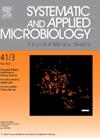Genomic and metabolic characterisation of a novel species Magnetominusculus dajiuhuensis DJH-1Ts sp. nov. from an acidic peatland
IF 4.2
2区 生物学
Q2 BIOTECHNOLOGY & APPLIED MICROBIOLOGY
引用次数: 0
Abstract
Magnetotactic bacteria (MTB) are recognised widely for their ability to synthesise intracellular magnetite (Fe3O4) and/or greigite (Fe3S4) nanocrystals and align with Earth's magnetic field. They are crucial for understanding prokaryotic organelle biogenesis. MTB members of the Nitrospirota phylum (previously known as the Nitrospirae phylum) are of interest due to their important ecological roles in the biogeochemical cycling of iron and sulphur. Here, we introduce Magnetominusculus dajiuhuensis DJH-1Ts, a newly discovered Nitrospirota MTB species that thrives in the acidic Dajiuhu Peatland of central China. By combining electron microscopy, 16S rRNA gene-based analysis and genome-resolved metagenomics, we elucidate its distinctive morphology, genomic features, and metabolic functions. The metagenome-assembled genome, assigned to the genus Magnetominusculus, family Magnetobacteriaceae, order Thermodesulfovibrionales, class Thermodesulfovibrionia according to the GTDB taxonomy, reveals an obligate anaerobe that lives in central China's largest wetland. We propose the formal name Magnetominusculus dajiuhuensis DJH-1Ts sp. nov., following the SeqCode system. Genomic and metabolic characterisation of this novel species suggests its potential role in nitrogen, sulphur, and carbon metabolism in aquatic biogeochemistry, particularly in peatlands. The genome of this novel strain indicates that it harnesses the Wood-Ljungdahl pathway for carbon fixation and acetate metabolism in anaerobic conditions, while its potential role in nitrogen cycling is characterised by denitrification and nitrogen fixation. It also participates in reduction of sulphate to sulphide, indicating a role in sulphur cycling in its ecological niche. Taken together, the discovery and characterisation of Magnetominusculus dajiuhuensis DJH-1Ts provide new insights into MTB diversity and ecological functions, particularly in peatland biogeochemistry.
酸性泥炭地大九湖磁管新种DJH-1Ts sp. 11 .的基因组和代谢特征
趋磁细菌(MTB)因其合成细胞内磁铁矿(Fe3O4)和/或灰长岩(Fe3S4)纳米晶体并与地球磁场对齐的能力而得到广泛认可。它们对于理解原核生物细胞器的生物发生至关重要。亚硝基螺旋体门(以前称为硝基螺旋体门)的MTB成员因其在铁和硫的生物地球化学循环中的重要生态作用而受到关注。本文介绍了一种新发现的生长在中国中部酸性大九湖泥炭地的亚硝基螺旋体MTB。通过结合电子显微镜、16S rRNA基因分析和基因组解析宏基因组学,我们阐明了其独特的形态、基因组特征和代谢功能。根据GTDB分类,将其归为Magnetominusculus属,Magnetobacteriaceae, Thermodesulfovibrionales目,Thermodesulfovibrionia纲,并通过宏基因组组装,揭示了一种生活在中国中部最大湿地的专性厌氧菌。根据SeqCode系统,我们建议将其正式命名为Magnetominusculus dajiuhuensis DJH-1Ts sp. nov.。这种新物种的基因组和代谢特征表明,它在水生生物地球化学中,特别是泥炭地的氮、硫和碳代谢中具有潜在的作用。这种新菌株的基因组表明,它在厌氧条件下利用Wood-Ljungdahl途径进行碳固定和醋酸盐代谢,而其在氮循环中的潜在作用以反硝化和固氮为特征。它还参与硫酸盐还原为硫化物,表明其生态位中硫循环的作用。综上所述,大jiuhuensis Magnetominusculus DJH-1Ts的发现和特征为MTB多样性和生态功能,特别是泥炭地生物地球化学功能提供了新的认识。
本文章由计算机程序翻译,如有差异,请以英文原文为准。
求助全文
约1分钟内获得全文
求助全文
来源期刊

Systematic and applied microbiology
生物-生物工程与应用微生物
CiteScore
7.50
自引率
5.90%
发文量
57
审稿时长
22 days
期刊介绍:
Systematic and Applied Microbiology deals with various aspects of microbial diversity and systematics of prokaryotes. It focuses on Bacteria and Archaea; eukaryotic microorganisms will only be considered in rare cases. The journal perceives a broad understanding of microbial diversity and encourages the submission of manuscripts from the following branches of microbiology:
 求助内容:
求助内容: 应助结果提醒方式:
应助结果提醒方式:


